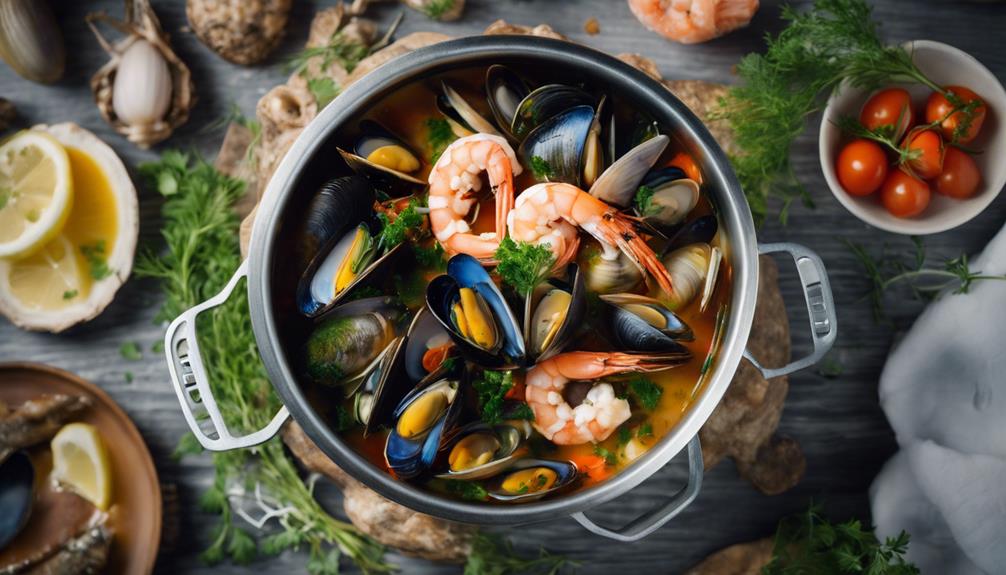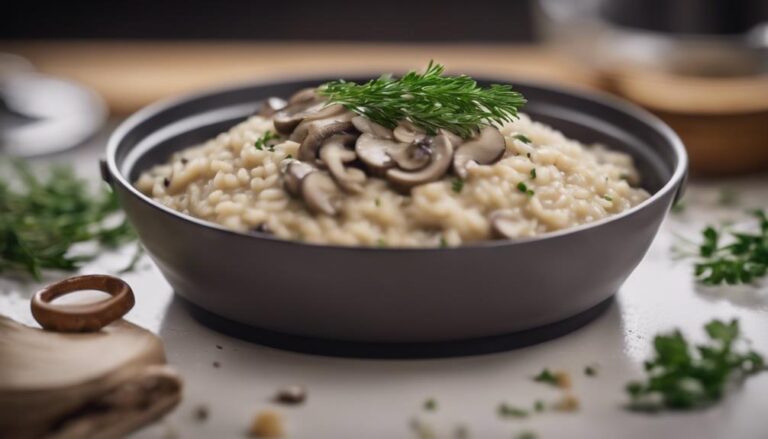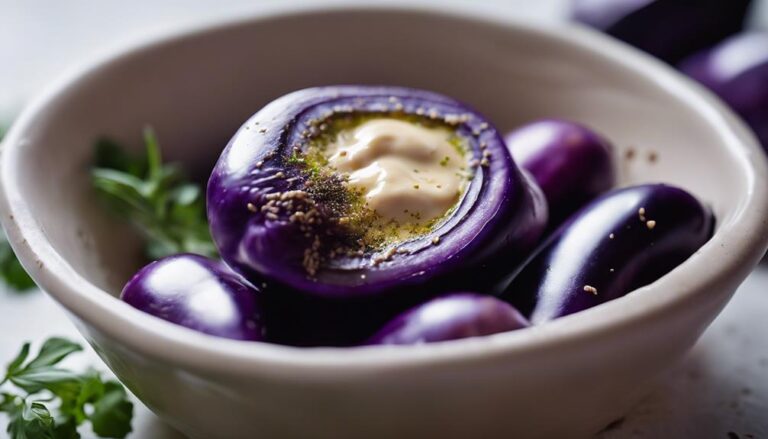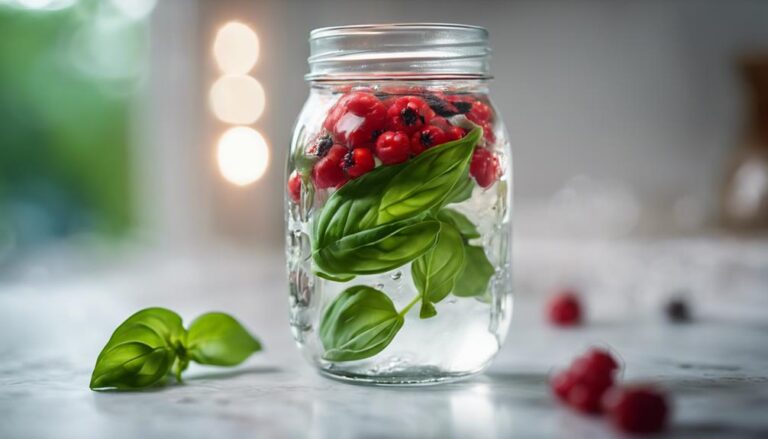Local Seafood Stew Sous Vide
Step into the world of local seafood stew sous vide, where the gentle cooking method melds flavors and retains moisture. Explore a symphony of perfectly tender seafood harmonizing with herbs and spices. Experience the meticulous care that elevates the broth to new heights. The rich flavors promise a memorable dining experience, capturing the essence of the sea in each bite. Whether you're a seafood enthusiast or a culinary adventurer, this sous vide creation will tantalize your taste buds and redefine your stew expectations. Reimagine seafood stew with a touch of sous vide magic.
What You Will Learn Here
- Sous vide enhances flavors and textures in local seafood stew.
- Precise temperature control ensures tender and flavorful seafood.
- Retains natural flavors and moisture for a memorable dining experience.
- Even distribution of cooking results in perfectly cooked seafood.
- Elevates traditional stew with harmonious taste profiles.
Seafood Stew Origins
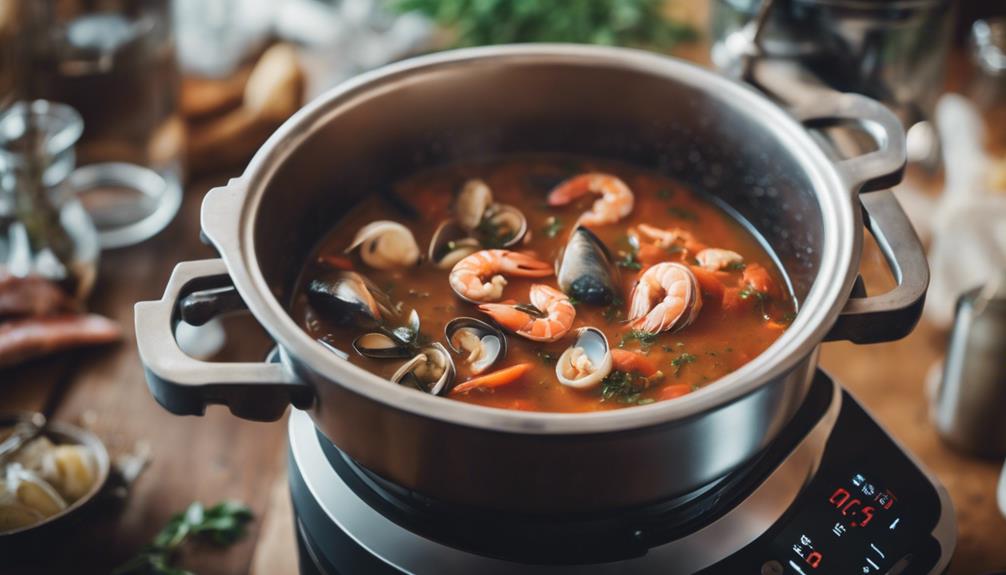
Let's explore the fascinating origins of seafood stew. Tracing its history, traditional ingredients, and regional variations can provide insight into the diverse culinary influences that have shaped it over time.
From the Mediterranean to the shores of New England, each region has added its unique twist to this timeless comfort food.
Seafood Stew History
Seafood stew has a rich and diverse history that spans across various cultures and regions, showcasing the culinary creativity of coastal communities. Its evolution reflects the cultural influences of societies that relied on the bounties of the sea for sustenance. Through centuries, stew making techniques have been refined, with each culture adding its unique twist to the dish.
From the hearty bouillabaisse of Provence to the spicy gumbo of Louisiana, seafood stews have adapted to local tastes and available ingredients. Modern innovations, such as sous vide cooking, have revolutionized the way stews are prepared, ensuring precise cooking temperatures and ideal flavor infusion. The history of seafood stew is a tapestry woven with the threads of tradition and innovation, making it a beloved dish worldwide.
Traditional Stew Ingredients
The evolution of seafood stew throughout history can be traced through the traditional ingredients that form the foundation of this culinary tradition. Seafood stews have been prepared using traditional methods that involve slow simmering to extract all the flavors from the ingredients.
Common traditional stew ingredients include a variety of seafood such as fish, shrimp, mussels, and clams. Vegetables like onions, garlic, tomatoes, and potatoes are often added to enhance the depth of flavor. Herbs and spices like parsley, thyme, bay leaves, and paprika contribute to the aromatic profile of the stew.
The combination of these ingredients, cooked slowly over time, results in a rich and flavorful broth that's characteristic of traditional seafood stews.
Regional Variations
Exploring the diverse regional variations of seafood stew reveals a tapestry of culinary origins and influences that have shaped this beloved dish across different cultures.
Seafood stew spices play an essential role in defining these regional differences, with some areas favoring bold, spicy flavors while others lean towards more delicate herb-infused broths.
Regional seafood preferences also heavily influence the type of seafood used, with some regions opting for shellfish like mussels and clams, while others focus on hearty fish such as cod or salmon.
Local seafood sources further contribute to the unique character of each variation, ensuring that the stew reflects the freshness and quality of the ingredients.
Additionally, seafood stew presentation varies, with some regions emphasizing a rustic, hearty presentation, while others prefer a more refined and elegant serving style.
Key Stew Components
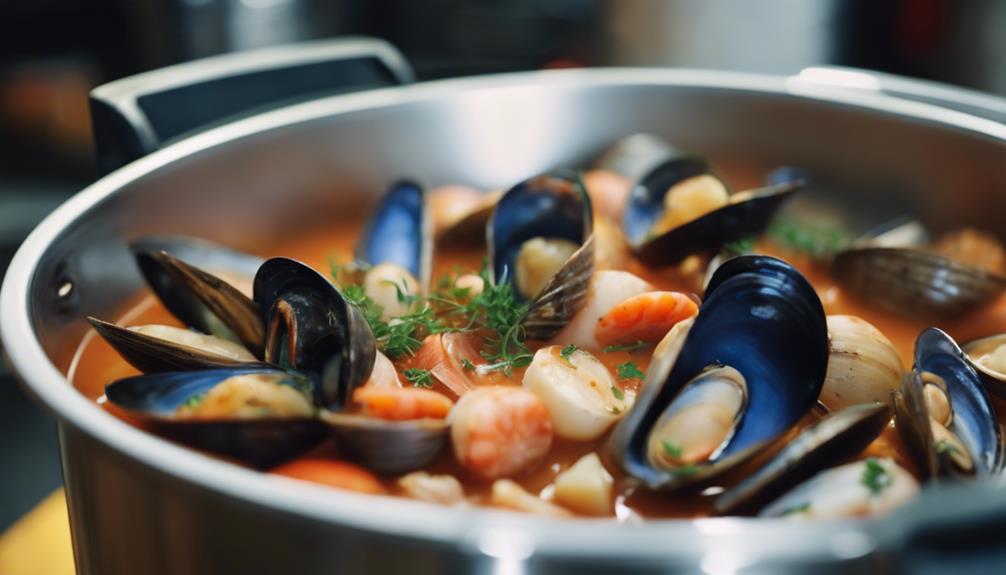
When crafting a flavorful seafood stew sous vide, the key components that contribute to its richness and depth of flavors are essential to take into account.
- Stew Preparation: The base of your stew sets the foundation for the entire dish. Sauteing aromatic vegetables like onions, garlic, and celery in olive oil before adding the seafood and broth can enhance the overall flavor profile. Incorporating herbs like thyme and bay leaves can further elevate the taste.
- Seafood Pairing: Choosing the right seafood is vital. Combining a variety of seafood like shrimp, clams, and fish can add complexity to the stew. Each type of seafood brings a unique texture and flavor, so selecting a mix that complements each other is key.
- Cooking Methods: Cooking sous vide allows the flavors to meld together slowly and gently, resulting in a tender and flavorful stew. The precise temperature control ensures that the seafood is perfectly cooked, retaining its moisture and tenderness.
Signature Seafood Stew Variations
Explore a world of flavorful possibilities with signature seafood stew variations like Sous Vide Seafood Medley, Sous Vide Lobster Bisque, and Sous Vide Mussel Chowder.
Each variation offers a unique blend of ingredients and cooking techniques that elevate the traditional stew experience.
Whether you're a seafood enthusiast or a culinary adventurer, these variations promise to tantalize your taste buds and redefine your stew repertoire.
Sous Vide Seafood Medley
For a delectable twist on traditional seafood stew, consider the flavorful combination of sous vide techniques with a medley of fresh seafood in this signature dish. When exploring sous vide seafood medley options, you can elevate your culinary experience with these unique creations:
- Sous Vide Scallop Risotto: Immerse yourself in a luxurious blend of perfectly cooked scallops combined with creamy risotto, creating a harmonious balance of textures and flavors.
- Seafood Pasta Sous Vide: Indulge in a tantalizing dish where sous vide cooking guarantees that each piece of seafood is tender and packed with the essence of the sea, complementing the pasta beautifully.
- Sous Vide Seafood Platter: Experience a symphony of seafood flavors as each element, from lobster to shrimp, is meticulously cooked to perfection using sous vide techniques.
Sous Vide Lobster Bisque
Indulge in the rich and velvety depths of sous vide lobster bisque, a luxurious twist on the classic seafood stew that promises to elevate your dining experience to new heights.
- Sous Vide Perfection: By cooking the lobster low and slow in a sous vide bath, every morsel becomes infused with a depth of flavor that traditional methods struggle to match.
- Creamy Elegance: The sous vide technique guarantees that the bisque base achieves a creamy texture without the risk of curdling or burning, resulting in a velvety smooth consistency.
- Intense Flavor Fusion: The controlled temperature of sous vide cooking allows the flavors of lobster, aromatics, and spices to meld together harmoniously, creating a bisque with an unparalleled depth of taste.
Sous Vide Mussel Chowder
Incorporating the delicate flavors of mussels into a velvety chowder through the precise technique of sous vide cooking guarantees a harmonious fusion of taste and texture in this signature seafood stew variation.
- Sous Vide Mussel Tenderness: Sous vide guarantees that the mussels are cooked to perfection, preserving their tenderness and natural flavors.
- Chowder Flavor Infusion: By cooking the chowder ingredients in a sealed bag at a precise temperature, the flavors meld together beautifully, resulting in a rich and flavorful chowder.
- Seafood Stew Sous Vide, Mussel Chowder Perfection: The controlled temperature of sous vide cooking allows the mussels to release their essence into the chowder, creating a dish that's both elegant and bursting with seafood goodness.
Sous Vide Cooking Techniques
When using sous vide cooking techniques, you benefit from precise temperature control, ensuring that your ingredients are cooked to perfection every time.
This method also provides even distribution of heat, resulting in consistently cooked dishes throughout.
Additionally, sous vide cooking helps retain the natural flavors of the ingredients, preserving the essence of your dish for a delightful culinary experience.
Precise Temperature Control
For precise temperature control in sous vide cooking, maintaining an exact degree is crucial to achieve consistent and best results.
Sous vide cooking methods rely heavily on temperature precision to guarantee that seafood dishes reach the perfect doneness without overcooking.
The advantages of sous vide, especially when preparing seafood, include locking in flavors and moisture while preserving the delicate texture of the ingredients.
By setting the water bath to the precise temperature required for each type of seafood, you can achieve excellent results every time.
This meticulous temperature control allows for a gentle and even cooking process, resulting in tender and flavorful seafood dishes that are sure to impress your guests with their quality and consistency.
Even Cooking Distribution
Achieving consistent cooking distribution in sous vide techniques enhances the overall quality and taste of your seafood stew. When cooking sous vide, the precise temperature control guarantees that your ingredients are evenly cooked from edge to edge, resulting in a perfectly cooked dish every time. This consistent cooking allows for ideal flavor infusion, as the ingredients have ample time to meld together and create a harmonious taste profile. To illustrate the importance of consistent cooking distribution in sous vide, consider the following table showcasing the difference it makes in your seafood stew:
| Traditional Cooking | Sous Vide Cooking |
|---|---|
| Uneven doneness | Even doneness |
| Flavors not blended | Enhanced flavor infusion |
| Potential overcooking | Precise cooking control |
| Inconsistent texture | Uniform texture |
| Limited flavor depth | Deep flavor penetration |
Retains Natural Flavors
Retaining natural flavors through sous vide cooking techniques is a hallmark of elevating the essence of your seafood stew to its fullest potential.
When you vacuum-seal your fresh ingredients and cook them at precise temperatures for an extended period, the flavors are locked in, resulting in a depth that traditional cooking methods often struggle to achieve.
The gentle cooking process allows for a seamless flavor infusion, ensuring that every bite bursts with the true taste of the sea.
Additionally, texture preservation is another significant advantage of sous vide cooking. By cooking your seafood stew in a controlled water bath, you maintain the delicate textures of the ingredients, creating a harmonious balance between tenderness and juiciness that will delight anyone you serve.
Final Thoughts
In conclusion, pondering the intricate flavors and textures of this local seafood stew prepared sous vide showcases the meticulous care and precision that are crucial in crafting a truly outstanding dish. The flavorful broth, enhanced through the sous vide process, speaks volumes about the benefits of this cooking technique. The tender seafood, infused with the essence of the herbs and spices in the broth, creates a harmonious symphony of tastes that dance on your palate with each spoonful.
When you serve this local seafood stew prepared sous vide to your guests, you aren't just offering them a meal; you're presenting them with an experience. The sous vide method ensures that every bite is perfectly cooked, allowing the flavors to meld together in a way that's simply not achievable through traditional cooking methods. Your guests will appreciate the effort and attention to detail that goes into creating such a dish, making it a memorable dining experience for all.
Frequently Asked Questions
Can I Substitute Seafood in the Stew With Other Proteins?
You can swap seafood in the stew with protein alternatives like chicken, tofu, or mushrooms for a twist. Experiment with ingredient swaps to create flavor variations. Consider marinades or spice blends to complement the change.
How Do I Adjust the Recipe for a Larger Batch?
To adjust the recipe for a larger batch, double or triple the volume of ingredients. When cooking, guarantee even heat distribution by using larger pots or pans. Be mindful of longer cooking times for thicker stews.
Are There Any Vegetarian Options for This Stew?
For a vegetarian twist on this stew, consider adding meat substitutes like tofu, tempeh, or seitan. These alternatives can provide a similar texture and protein content to the dish, ensuring a satisfying and flavorful meal.
Can I Use Frozen Seafood for This Recipe?
Yes, you can use frozen seafood for this recipe. While fresh seafood is often preferred, frozen can work well too. Consider adjusting the sous vide cooking time slightly for frozen seafood to guarantee perfect doneness.
What Is the Recommended Serving Temperature for the Stew?
For the stew, the recommended temperature is around 140°F for perfect doneness. Adjust serving sizes based on your guests' appetites. Enjoy this comforting dish at the ideal temp to savor every flavorful bite.
Conclusion
Indulge in the rich flavors of local seafood stew sous vide, a dish that combines the freshest ingredients with innovative cooking techniques.
The tender seafood, aromatic broth, and perfectly cooked vegetables come together in a harmonious blend of flavors that will leave your taste buds craving for more.
With sous vide cooking, you can elevate this classic dish to new levels of culinary excellence, making it a must-try for seafood lovers everywhere.
